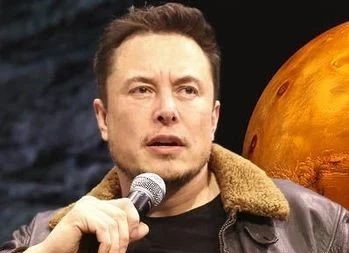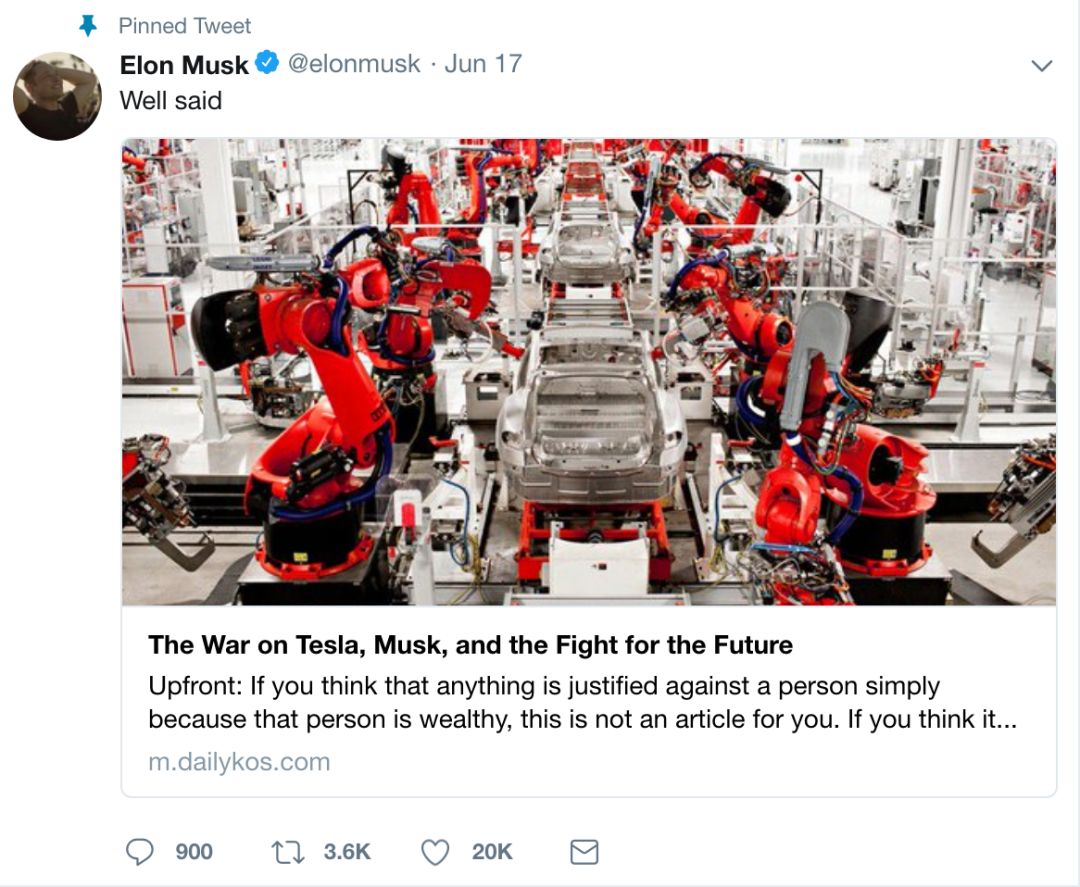
The original title of this article is “The War on Tesla, Musk, and the Fight for the Future,” shared by a Tesla owner named Rei. You can feel the heavy love and hate from a Tesla supporter and see the true colors of Tesla’s supporters and opponents.
This reminds people of the various obstacles that GM encountered when promoting the EV1. It also reminds people of what Zhu Xiaotong, the President of Tesla China, said in a speech: “As an industry that has been eliminated twice, if we cannot control our own destiny and achieve maximum self-sufficiency in a seemingly difficult way, we cannot realize our vision.”
Xiao Wang, a member of the 42HOW translation team, translated this article. Thank you, Xiao Wang. If you want to join the translation team, you can contact Xiao Wang’s WeChat at the end of the article.
Foreword: If you think defending someone just because they are wealthy, this article is not for you. If you think you can lie, mislead, or attack someone just because of their financial situation, then you don’t need to read this article. You won’t finish it.
Whenever we discuss Tesla with people who are not very familiar with it, we, Model 3 owners and those on the waiting list, will notice a strange tendency that is annoying but too easy to explain:
- “Tesla…haven’t they gone bankrupt?”
- “It’s a pity that you will never get your car as Tesla is going bankrupt soon. Their cars sell one unit lost one unit.”
- “Is this the car that killed someone?”
- “I don’t want to get into a Tesla. Too many of them have caught fire.”
- “But their management is in chaos.”
- “I can’t support Tesla as they treat their workers too poorly.”
Why do people have these reactions? The reasons are disappointing but obvious.
Let’s start with the basics.
It is not an exaggeration to say that Tesla’s success will cause some people to suffer a great loss
Contrary to the recent popular saying that “Tesla is favored by the media,” Tesla has been blacklisted since its inception.In the era when Tesla Roadster 1 was released (2007), TTAC (The Truth About Cars, an American automotive review website under Autoguide) launched a series of columns called “Tesla’s Last Breath,” which was said to be counting down to Tesla’s inevitable bankruptcy.
Top Gear staged a famous scene where the Roadster ran out of electricity on the track and had to be pushed off (it didn’t actually happen), as well as a dangerous braking failure (which was only due to a blown fuse, and the brakes never actually failed), and a bunch of made-up stories about electric cars, especially the Roadster, involving charging time, range, and overall usability.
But these are only some conceptual conflicts. Today’s opposition is much stronger.
Tesla’s stock is the most shorted stock in the United States, with $10.7 billion being shorted.
What does this mean?
In short selling, you borrow the stock you want to short from shareholders and pay interest, then immediately sell the stock and agree to buy it back and return it to the original shareholder at a later date. Because the shareholder didn’t intend to sell these shares originally, short sales increase the number of sell orders in the market, driving down the stock price. Conversely, when the short seller closes out their position and buys the stock back to return it to the original shareholder, there are many buy orders in the market that didn’t previously exist, driving up the stock price.
Short selling has always been dangerous, and it’s even more dangerous when a significant portion of stock is held by short sellers.
Strictly speaking, the downside risk of short selling is limitless: if you short a stock at $1 and the stock rises to $1 million, you’ll suffer a loss of 1 million times your original investment. To prevent short sellers from being caught in an impossible situation, short selling contracts include the obligation to close out their position when the stock price rises too high (i.e., buy the stock back and return it). However, when short sellers close out their positions, the stock price is pushed up, which in turn causes other short sellers to be forced to close out their positions, and this self-perpetuating cycle is called a short squeeze.
The more a company’s stock is shorted, the greater the risk of a short squeeze and the more the stock price rises during this period. In Tesla’s short squeeze, short sellers need to buy nearly 1/4 of the outstanding shares in a short period of time, but most holders of Tesla stock are long-term investors, so they don’t want to sell, which creates even more upward pressure on stock prices.
Tesla has already gone through several rounds of short squeezes in the past (because many people either don’t believe in electric cars, don’t believe in new car makers, or simply don’t like Musk), but never on this scale. I reiterate, if Tesla’s stock price rises too high, the short sellers who bet $10.7 billion on Tesla’s failure will be left with nothing.As of now, they are still able to control the situation. With the production issues of Model 3 being resolved, the company is headed towards profitable Q3 and Q4. However, this tactic is no longer effective: they will soon run out of stocks to short. Only a small portion of stocks are currently available for lending, and shorts cannot continuously borrow and sell stocks, as the remaining institutions with available stocks demand a significantly higher interest rate.
Honestly speaking, shorts can only hope to suppress the stock price with fear, anxiety, and doubt, as their $10.7 billion is at stake.
Get to know who the shorts are up against
Most people’s impression of Tesla shareholders is a group of Silicon Valley hippies investing to save Mother Earth. This is far from reality.
According to the shareholding ratio, Tesla’s shareholders are as follows:
-
T. Rowe Price Associates, Inc. (9.21%) – a well-known American asset management company with nearly $1 trillion in assets under management
-
Fidelity Management and Research Company (8.23%) – one of the largest asset management companies in the US, with assets under management of $2.4 trillion
-
Baillie Gifford & Co Limited. (7.53%) – a long-established asset management company in the UK
-
Tencent Holdings Ltd (4.95%) – Tencent Holdings
-
Vanguard Group Inc (4.20%) – the second-largest asset management company in the world, with assets under management of $5.1 trillion
-
Capital World Investors (2.62%) – a Capital Group-owned fund, Capital Group is one of the largest fund management companies in the US with assets under management of $1.7 trillion
-
BlackRock Institutional Trust Company (2.04%) – a BlackRock fund, BlackRock is the world’s largest asset management company with assets under management of $6.2 trillion.* Jennison Associates LLC (2.00%) – the stock investment department of PGIM, a subsidiary of Prudential Financial Inc. PGIM manages assets worth 1 trillion USD.
-
BlackRock Inc (1.29%) – BlackRock
-
State Street Corp (1.47%) – State Street Bank and Trust Company
-
BAMCO Inc (0.96%) – an American investment management company
-
Invesco PowerShares Capital Mgmt LLC (0.81%) – an American investment management company
-
Susquehanna Financial Group, LLLP (0.75%) – the economic business department of SIG Haina International
-
PRIMECAP Management Company (0.65%) – an American investment management company
-
Geode Capital Management, LLC (0.61%) – an American investment management company
-
Goldman, Sachs & Co. (0.57%) – Goldman Sachs
-
Morgan Stanley & Co Inc (0.55%) – Morgan Stanley
Approximately 3/4 of Tesla’s stocks are held by large institutional investors who have built their fortunes by investing in quality stocks. Additionally, institutional investors have recently increased their holdings in Tesla.
Shorts are not betting against Tesla with dirty hippies, but against Wall Street’s number crunchers (smart investors).
So why do these investors invest in Tesla?
Tesla’s Gross Profit per Car is High
A common misunderstanding is that Tesla loses money on every car sold.
Only the most naive calculations would suggest that: quarterly losses divided by volumes sold. This does not take into account the significant amount Tesla spent in building large factories prior to the high volume production of Model 3, expanding sales and service centers, and improving the charging network.
Some fast-growing companies are in the red (such as Amazon). Not losing money would be irresponsible. No investor wants to see dividends distributed when the company is still small. They want to maintain an acceptable loss while using all funds to expand the business.
So what’s Tesla’s gross profit per car? To answer this question, we turn to Tesla’s quarterly reports.
When the production of Model 3 was very low, in other words, if only Model S and Model X were calculated, Tesla’s automotive department had a Non-GAAP gross profit of 25% and a GAAP gross profit of 27.9%. However, when Model 3 started ramping up and encountered well-known troubles, Tesla’s gross profit dropped to a minimum of Non-GAAP 13.8% and GAAP 18.3%, and then rebounded to Non-GAAP 18.8% and GAAP 19.7%.
Now, the main expenses that affect Tesla’s profits are R&D and sales/management. When the production increases, the first expense will hardly increase. The second expense will increase to some extent with the production, but it is not a completely linear growth. The major impact is that you need to pay a large portion of these expenses before the production ramp-up.
In short, in the next few years, these expenses will all be covered by the (continuously growing) automotive business gross profit, not to mention that Tesla will also start ramping up its solar and energy storage product lines in the second half of this year.
Let’s pretend that none of what was just discussed is the actual situation.
To prove my point, let’s assume that Tesla is now in trouble.
However:
- Tesla has a large number of tangible assets that can be used as collateral for loans;
- Tesla can easily reduce R&D expenses (and to some extent, sales and management expenses), which are the two main expenses;
- Tesla can issue new stocks: nearly 500,000 people are waiting for delivery, and the inherent value of the company means that there will always be buyers;
- Musk can easily increase orders from SpaceX (and to some extent, orders from the Boring Company). SpaceX has already achieved tremendous success, is explosive, and has ample cash;
- Musk can sell some of SpaceX’s shares to save Tesla. There are long queues of potential buyers at the door of SpaceX, but their wishes have not been fulfilled because SpaceX is a private company. In addition, Musk’s personal history has repeatedly proven that he is not afraid of putting all his eggs in one basket.
In conclusion: Tesla is absolutely impossible to go bankrupt. Period.
Oh, and I forgot to mention the resignation of management: Tesla does not have an abnormally high turnover rate for its management, but rather an abnormally high number of employees at the director/vice-president and above levels.## However, fear-mongering does not seem to diminish
Every year, 1.3 million people die in traffic accidents. How many of these accidents are you aware of?
Yet whenever someone dies in a Tesla (which is becoming more and more frequent), the news always makes it to the front page, sometimes with weeks of follow-up reporting. If a Tesla catches fire, the story becomes “Electric cars catch fire easily and are unsafe” or “Teslas catch fire easily and are unsafe,” even though these stories have been debunked years ago and recently.
Data shows that gasoline cars are five times more likely to catch fire per mile travelled than electric cars. In the US alone, 174,000 gasoline and diesel cars catch fire and burn every year. Where are the headlines about that?
If anyone is interested in why Teslas are safe, it’s because the individual battery cells are not only physically isolated but also surrounded by non-flammable coolant. When a single cell is punctured, the heat produced is only released into the coolant. It is only when the battery pack is severely damaged that a fire is possible.
In the following picture, a Tesla with a severely damaged front end still did not catch fire (because the battery pack is installed further back, under the passenger compartment).
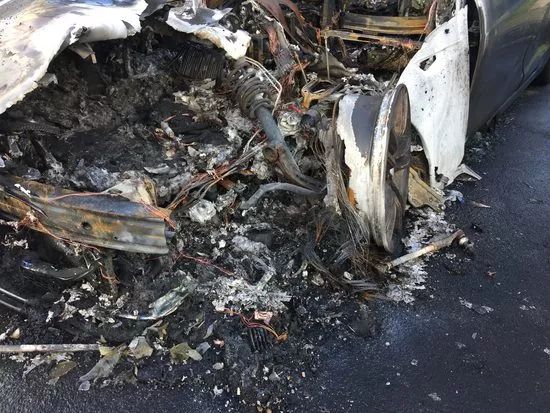
Of course, if there is no vehicle fire, the standard way of bashing Tesla is to blame the Autopilot.
So far, Teslas are the most popular brand with Level 2 self-driving functionality on the road.
Level 2
Level 2 means the combination of human driver and computer, and ultimately controlled by the human driver. This is different from Level 3 (controlled by the computer, but the human driver must be able to take over the driving within a short period of time after being reminded), Level 4 (controlled by the computer and can avoid trouble by itself, but the computer cannot control it in all driving environments), and Level 5 (fully controlled by the computer without the need for human intervention) autonomous driving.
Autopilot
In the already traveled miles of Tesla, 1/3 to 1/2 of the miles were driven under the conditions of Autopilot system being enabled.
Take the recent Tesla accident near San Ramon, California reported in this article (Note 1) as an example. The first sentence of the news report infers that Autopilot was turned on! Then the fourth paragraph infers it again! And then a paragraph discussing the death caused by the Autopilot system summarizes the whole article. No problem!
Because when you do not know the truth, spreading rumors is certainly the most responsible practice, right (shrug)? Of course, the fact is hidden in this small paragraph of the article: it is still uncertain how fast the car was driving on this 35 mph speed-limited road, but Jacowitz (spokesperson for the California highway) said “it was fast enough to veer off the roadway, hit the guardrail and continue driving along the riverbank for some time before plunging into a pond”.
On this 35 mph speed-limited road, the fastest speed allowed by Autopilot is 40 mph. If the car was driving fast, Autopilot couldn’t have been turned on! Even if there were so many facts presented to them, did they bother to mention it in the news report? Of course not.
It should also be mentioned that, like most accidents, Autopilot was not active in this accident. The initial story received massive coverage. What about the subsequent truth? Only very few reports.
Of course, when Autopilot really goes wrong, they will use lengthy reports to cover it. They are still reporting on a highway accident involving Autopilot. A Tesla collided with a parked fire truck after Autopilot was turned on and the female driver (playing with her phone and not paying attention to the road) fractured her ankle. Let me repeat, a Tesla collided with a parked fire truck in a high-speed accident, and the female driver only had a fractured ankle.
Tesla has an impressive safety record, with one fatal accident occurring every 320 million miles on average, while the US average is 86 million kilometers. It is true that Tesla vehicles are relatively more updated and expensive, but this is still a very good safety record. In addition, it is reiterated that 1/3 to 1/2 of Tesla’s mileage was driven under the enabled state of the autonomous driving system.Translated English Markdown Text with HTML tags:
This is why we feel frustrated when we hear someone say “Is this the car that kills people?”
Slightly off-topic: We may all know about Consumer Reports’ test of Model 3, how much they liked it, but still couldn’t recommend it.
The specific reason is that after an emergency braking test, Model 3’s subsequent braking performance was unstable, and some even worse than a pickup truck. They also pointed out the problem of wind noise and hard suspension (although these issues have been resolved months ago and Consumer Reports tested an early version of Model 3).
What is not well known is that Tesla remotely diagnosed the brake problem (ABS calibration), solved it within a day, and released a patch within a week. Compare this incident with General Motors’ denial of ignition switch door issues for several years?
Just a few days ago, Fiat announced the recall of 5.3 million cars because the cruise control could not be turned off-the driver had to step on the brake pedal in a panic to stop the vehicle. Tesla’s large amount of coverage was obtained because the brake distance was as good as that of a pickup truck after two consecutive emergency brakes, and the coverage of Fiat’s serious recall was almost zero.
In any case, Consumer Reports plans to retest.
With UAW, who cares about shorts?
I usually support unions very much. In this company, I am a union member, and I voted in favor of establishing a union (unsuccessful) in the previous company. But the actions of UAW on Tesla make me feel like I have eaten flies.
Tesla’s Fremont factory was originally NUMMI (New United Motor Manufacturing, Inc), a joint venture between General Motors and Toyota, and it was also UAW’s territory. In the late 2000s, when the automotive industry was in a downturn, automakers were reducing the number of jobs in the United States. In order to keep UAW’s jobs in Detroit headquarters, UAW gave up the NUMMI factory like a hot potato, and the workers were extremely angry at that time.
Because of Tesla’s entry, many unemployed workers were able to work again, and UAW was as unwelcome as a plague in the Fremont factory. In the past few years, UAW has been trying to organize a union in the factory but has not received enough signatures; they can even attract workers to attend their free BBQ. Well, if you can’t beat Tesla, why not spend $500,000 a year to smear Tesla?The UAW always says that Tesla’s factory is “unsafe.” Their evidence is usually data from three years ago (when Tesla was learning mass production), which showed that Tesla’s factory had a 33% higher rate of personal injury accidents than the national average (8.8 recorded personal injury accidents per 100 workers).
The UAW not only ignores the fact that Tesla’s current personal injury rate is now similar to the national average, but also does not mention that before Toyota intervened, UAW had set up a union at the factory that recorded 30-45 personal injury accidents each year, even in later years, the accident rate of the factory was twice as high as Tesla’s current level.
(Note-Musk has publicly proposed to vote to form a union)
Enter the Reveal website, an “independent news organization,” begins to “report” on Tesla. The double quotes are generally used to indicate sarcasm, which is exactly what I want to express.
Reveal seems to have taken it upon themselves to prove that Tesla’s Fremont factory is an exceptionally dangerous place, accompanied by the ubiquitous shadow of the UAW.
It’s strange that they never report on any industrial injury accidents that happen outside of Tesla. I guess that’s because other car companies are flawless. In addition, they strongly advocate that Tesla is covering up personal injury records, ignoring that the California Occupational Safety and Health Administration is the country’s strictest regulatory agency with regard to safety and health, and that Tesla has never been accused of concealing accident records by them (but the other three major car companies in the United States have been accused, but you won’t hear that news from Reveal).
They focus on “personal stories” that are easy to manipulate because even if the story is false, Tesla may not be able to respond as it could potentially interfere with a future lawsuit.
Their first “personal story” is about a person who was involved in the construction of the Tesla factory being told that they could not use yellow caution tape or forklifts with buzzers in the factory because it would upset Musk.
Obviously, Reveal either has never heard of Google or can’t spare 30 seconds to verify the facts. It’s very simple, just go to Google Images or YouTube and search for Tesla’s Fremont factory, you will see the following scenes:
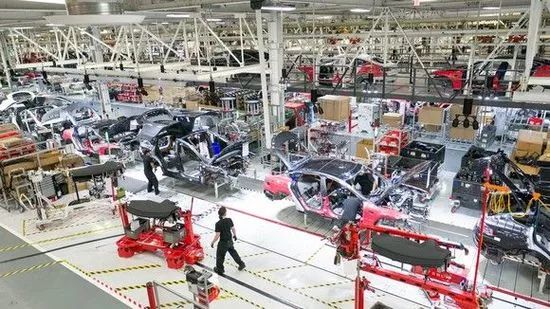
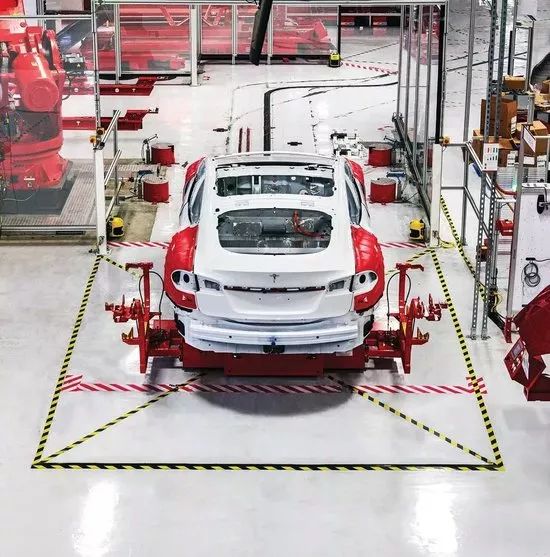
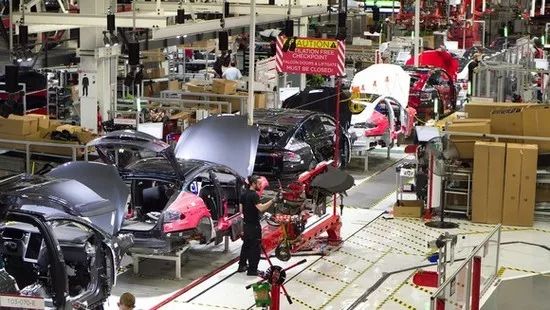
There are many things like this, but it’s impossible to list them all.
Unable to tolerate the countless harassment from Reveal, Musk sarcastically responded on Twitter:
Ok, we can do the interview at the yellow protective fence or over by the noisy beeping thing. Please send your meeting request to wakasliar@tesla.com – no fake media or other intermediary is needed.
— Elon Musk (@elonmusk) May 28, 2018
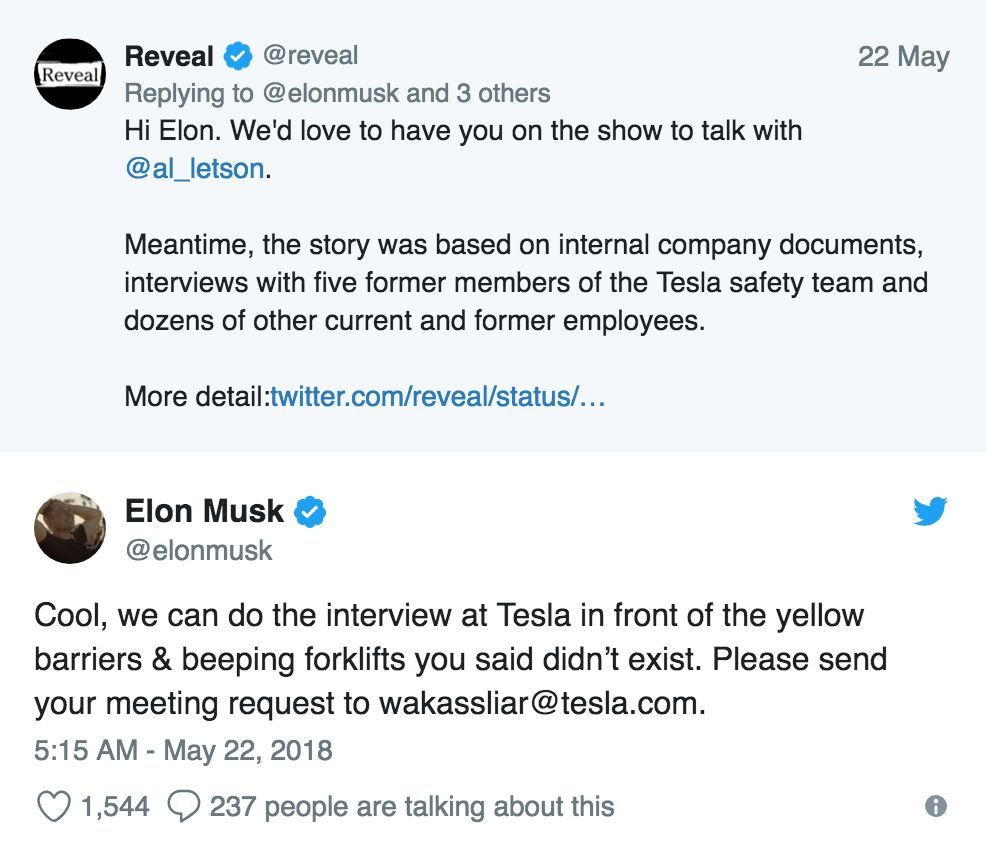
Now, having been corrected appropriately, Reveal practiced their new values of accurate and timely news by retracting this article…just kidding, they did not! They did not mention their erroneous report and continue to add to their series of negative reports on Tesla.
In Reveal’s report, you can see them applying the same standard of fact-checking to all their reports.
You can see a person struck by an arc thrown “5-6 meters high” because it’s obvious we all live in a cartoon and the laws of physics no longer apply. (Yes, we have all seen people thrown a great distance by explosions in movies, but it doesn’t happen in the real world; it’s created by hydraulic lifts in the film industry).
You will also see a story about a person standing next to welding metal who suffered “permanent lung damage” from inhaling metal smoke because the metal caught fire.
As a welder myself, I am familiar with such injuries: it’s true that a piece of galvanized steel can catch fire after being overheated, and if you inhale too much smoke from the burning metal, you will develop symptoms very similar to the flu. Similarly to the flu, inhaled too much smoke will either kill you or slowly subside like flu symptoms. Zinc is a nutrient that the body can slowly digest even if the body has received an excess amount. It is impossible to suffer permanent damage from inhaling too much zinc smoke.
Of course, Reveal is not interested in fact-checking. If you have any dirt on Tesla, be sure to call Reveal; they will write it no matter what you say.
Entering the World of TwitterThere was a time when I felt only Tesla owners and those on waiting lists were extremely frustrated with the way Tesla was being reported in the media. Musk occasionally had some emotional responses or counterarguments, but most of the time, it was quiet.
This changed last week. Musk was angry about the false news that he met with the Saudi Crown Prince and Reveal, which was supported by a radical UAW on his Twitter timeline. He began tweeting about his dissatisfaction with these false reports and announced the creation of a crowdsourcing website where users could rate news accuracy.
Then Twitter users lost their minds collectively.
As a result of just one weekend, four new controversial topics emerged on Twitter, ranked from least interesting to most interesting:
-
Nanogate: Musk (responding to someone’s criticism) criticized a person for not being a real scientist because they crowdfunded “nanotechnology” research. Musk believed that nanotechnology is a vacuous and fashionable term. This was widely spread on Twitter (with some media, but mostly Twitter) as “Musk hates science.”
-
Cultgate: A person (Jens Erik Gould) who holds official journalism credentials tweeted @Musk about a column published on The Knife, analyzing recent media coverage of Musk, pointing out that many descriptions in the reports were ambiguous, and any story was focused only on one viewpoint, which is biased.
Musk did not know (which was not a very obvious fact) that Gould was involved in a recent cult organization (NXIVM), and The Knife was one of the organization’s websites. After being pointed out, Musk deleted his retweet and apologized. This was described (mostly by the media) as Musk randomly retweeted a cult site column just because the viewpoint was pleasing.
- Misogyny Gate: An Erin Biba, a journalist, who had previously verbally attacked Musk (including his genitals) on Twitter, was found to have hidden these tweets, and accused Musk of “attacking science.” Musk replied, “I never attacked science, but I definitely attacked dishonest journalists like you.”
The conversation above had nothing to do with gender, but Biba responded to Musk, accusing him of misogyny. She recently talked about her personal attacks from “Musk’s brothers” in her column on Daily Beast, claiming that Musk’s Twitter supporters were a group of “angry men,” although a rough search found that the gender ratio of his followers is roughly 50/50.“`markdown
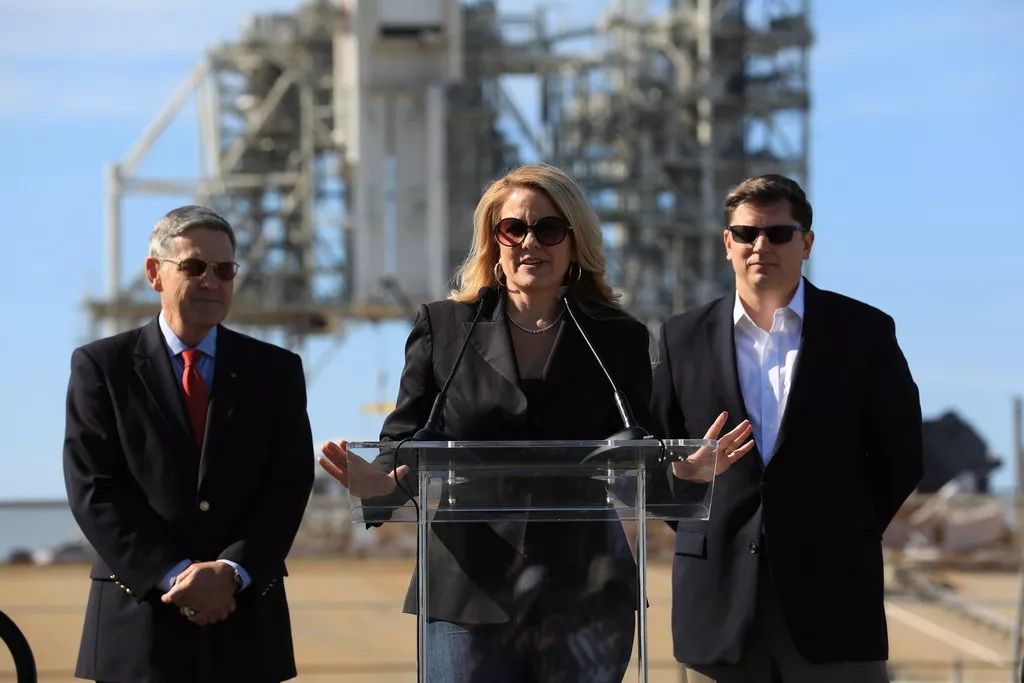
- Anti-Semitic Gate: This is probably the most ridiculous one. Someone tweeted @ElonMusk, saying that a person in power is trying to destroy the media. Elon Musk responded: “Who do you think ‘owns’ the media?” This is a concept that many people who are annoyed with Sinclair Broadcasting Group, the largest local TV station owner in the United States, and the Murdoch Empire, can agree with.
Of course, if you can use this opportunity to discredit someone, why bother interpreting something in context? Yes, Twitter users and some shameless media interpreted this as Musk claiming that Jews control the media. What is even more annoying is that Musk’s Twitter timeline was flooded with scumbags.
Clarification:
To Josh Top, a spokesperson for aspiring news and Rodin, Musk pointed out that if you believe that public opinion polls are controlled by powerful people, the media is actually owned by the same group of people. Anyone who thinks this is anti-Semitic is just revealing their own bias. The context of this sentence is clear.
— Elon Musk (@elonmusk) May 28th, 2018

Declaration: Although Musk is not Jewish, Elon is a Hebrew name and he is proud of it. During the spring break this year, Musk took his children to Israel to learn about the country’s history.
I paid tribute to Massada (the symbol of the ancient Jewish state) earlier today. Freedom or death.
— Elon Musk (@elonmusk) May 19th, 2018 4:36 pm Pacific Time
In summary: I disagree with Musk on many things. I think his news evaluation website is a stupid idea (crowdsourcing only brings controversy and repeat voting). I disagree with his cosmic simulation hypothesis, or that intelligent AI is just around the corner. I think automatic driving will come later than he expected, and Venus will be a better place to colonize than Mars.
“`I could lay out a long list of our past disputes, but recently the distortion and vilification of anything related to him has reached an absurd level.
Similarly with Tesla, you could say they set an overly aggressive schedule and failed. Their earlier produced vehicles did not meet the expected level of refinement (even so, Tesla still enjoys very high levels of customer satisfaction). The delay of Model 3 formation will slow down Tesla’s expansion speed and give some later entrants into the electric vehicle field the opportunity to catch up with Tesla in the next few years (especially Volkswagen, who has finally started investing heavily).
But overall, Tesla is moving along a cautious path – first realizing the potential of lithium batteries in the electric vehicle field, changing the image of lithium batteries, changing the public’s understanding of charging time, and simultaneously pursuing cost reduction while maintaining profit margins through economies of scale.
Whether you like Tesla or not, they will continue to exist in the foreseeable future. No matter how much those who shorted Tesla at $250 rage at their short positions failing, or how much negative news they can create.
If you are still interested…
Model 3 timeline:
-
Production capacity before the recent shutdown: Different production lines have different speeds, ranging from 3,500 to 6,000 vehicles per week;
-
The recent shutdown was to increase production capacity to the target of 5,000-6,000 vehicles per week for this quarter;
-
Target for the next quarter: Stable production capacity of 6,000 vehicles per week and increased automation. The third quarter will be Tesla’s first sustainable profitable quarter (although I personally hope that they will not reduce their investment in expansion just to please investors);
-
Current delivery focus: To avoid triggering federal tax credits and deductions after selling 200,000 vehicles too early, the delivery focus is on Canada and inventory (meaning that full credit will still be available in the fourth quarter of this year, half of next year, one-fourth of the second half, and then it will be gone);
-
All-wheel drive and performance packages: In the process of being released. The performance package will be delivered earlier than the all-wheel drive;
-
Standard battery pack: Will be released 3-6 months after reaching a production capacity of 5,000 vehicles per week. Therefore, if Tesla achieves a production capacity of 5,000 vehicles per week in June as planned, the standard version will be released between September and December. If the production capacity target is not achieved until July, the standard version will not be available until October-January of next year;
-
European/Chinese-spec vehicles: First half of 2019;
-
Right-hand drive vehicles: Middle of 2019.
注1: https://www.usatoday.com/story/tech/news/2018/05/21/tesla-model-s-crash-into-californiaa-model-s-crash-into-california-pond-killed-driver-police-say/630798002/



This article is a translation by ChatGPT of a Chinese report from 42HOW. If you have any questions about it, please email bd@42how.com.
